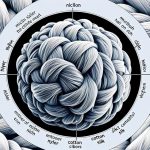Do you have a microfiber item that you’re dying to tie-dye? You may be wondering if it’s possible to achieve those beautiful, vibrant colors on this unique fabric. The answer is yes – you can absolutely tie-dye microfiber! With the right preparation, techniques, and care, you can transform your microfiber items into colorful, personalized pieces.
First, it’s important to understand the composition of microfiber. Microfiber is a synthetic fabric made from a blend of polyester and nylon fibers. It’s known for its softness, durability, and ability to absorb moisture quickly.
Because it’s a synthetic fabric, it can be a bit tricky to dye compared to natural fibers like cotton or silk. However, with the right steps and techniques, you can achieve stunning results on your microfiber items.
Let’s dive into the details of how to tie-dye microfiber and achieve vibrant, long-lasting colors.
Table of Contents
Understanding the Composition of Microfiber
Did you know that microfiber is a blend of synthetic materials and is incredibly absorbent? This material is made up of a combination of polyester and polyamide, which work together to create a soft yet durable fabric. These fibers are much finer than traditional fabrics, which allows them to trap dirt and moisture more efficiently. This makes microfiber a popular choice for cleaning supplies, towels, and even clothing.
Because microfiber is a synthetic material, it can be difficult to dye. Unlike natural materials like cotton or wool, microfiber fibers don’t absorb color in the same way. However, it’s possible to dye microfiber with the right materials and techniques.
One option is to use a specialized dye made for synthetic fabrics, such as Rit DyeMore. Another option is to use a dye that is specifically designed for polyester, since this is one of the main components of microfiber. Before attempting to dye microfiber, it’s important to note that the process can be more challenging than dyeing natural materials.
Because of its synthetic composition, microfiber is less porous and doesn’t soak up dye as easily. This means that you may need to use more dye or a longer dyeing process to achieve the desired color. However, with patience and the right materials, it’s possible to successfully tie dye microfiber and create unique and colorful items.
Preparation for Tie-Dying Microfiber
Before tie-dying microfiber, you should prepare the fabric properly to ensure the best results.
This involves choosing the right type of dye that’s suitable for microfiber material. Additionally, it’s important to pre-wash and dry the fabric to remove any impurities that may affect the dyeing process.
Choosing the Right Dye
When you’re looking for the perfect dye to tie-dye your microfiber, the key is to find a vibrant color that will make your heart skip a beat. You want a dye that will not only produce a beautiful color but also stick to the microfiber fabric.
Choosing a fiber-reactive dye is ideal for microfiber as it bonds well with the fabric and produces long-lasting results. Another factor to consider when choosing a dye is the type of microfiber you have. Some dyes work better on certain types of microfiber, such as polyester or nylon.
It’s important to read the label of the dye to see if it is suitable for the type of microfiber you are working with. By choosing the right dye, you can ensure that your tie-dye project turns out exactly how you envisioned it.
Pre-Washing and Drying the Fabric
To ensure the best results for your tie-dye project, start by washing and drying your fabric before beginning. This step is crucial in preparing the fabric to receive the dye and will help ensure that the colors come out vibrant and long-lasting.
Here are four simple steps to follow when pre-washing and drying your microfiber fabric:
-
Check the care label: Before washing your fabric, check the care label to ensure that it can be washed and dried in a machine. If not, follow the recommended instructions for hand washing and air drying.
-
Machine wash: Place the fabric in the washing machine and use a gentle cycle with cold water. Add a small amount of detergent and avoid using bleach or fabric softener, as these can affect the dye absorption.
-
Dry on low heat: Once the washing cycle is complete, transfer the fabric to the dryer and tumble dry on low heat. Avoid using high heat, as this can damage the fabric fibers and affect the dye absorption.
-
Iron if necessary: If your fabric is wrinkled after drying, you can use a low heat iron to remove any wrinkles before beginning your tie-dye project.
Methods for Tie-Dying Microfiber
One way you can add a pop of color to your microfiber items is by tie-dying them using specific methods. Microfiber is a synthetic fabric that’s made from polyester and nylon. It’s a popular choice for towels, cleaning cloths, and bedding, but it can be challenging to dye due to its synthetic nature.
The most effective method for tie-dying microfiber is using a combination of heat and vinegar. You’ll need to mix a solution of equal parts water and white vinegar and heat it in a pot on the stove. Once the solution comes to a boil, turn off the heat and add your dye to the pot. Then, submerge your microfiber item into the solution and let it sit for at least two hours. Afterward, rinse your item with cold water and wash it separately in the washing machine.
Another method for tie-dying microfiber is using a fabric dye specifically designed for synthetic fabrics. These dyes are typically available in a wide range of colors and can be found at most craft stores. To use this method, you’ll need to follow the instructions on the dye package carefully. This typically involves mixing the dye with water, adding it to a pot on the stove, and then submerging your microfiber item into the solution. After a certain amount of time, rinse your item with cold water and wash it separately in the washing machine.
Tie-dying microfiber can be a fun and creative way to add some personality to your home essentials. Just remember to pre-wash and dry your fabric and choose the right dyeing method for your needs. With a little patience and some experimentation, you can create unique and colorful microfiber pieces that’ll brighten up any space.
Tips for Achieving Vibrant and Long-Lasting Results
If you want to achieve vibrant and long-lasting tie-dye results on microfiber, try adding salt and vinegar to the dye mixture. The salt helps the dye adhere to the fabric, while the vinegar helps to set the color.
Another tip is to use a fixative, such as soda ash or vinegar, to further set the dye and prevent it from fading over time.
Adding Salt and Vinegar to the Dye
Adding salt and vinegar to the dye mixture can give tie dye patterns more depth and intensity, making for a more vibrant and unique finished product.
Salt helps to open up the fibers of the fabric, allowing the dye to penetrate deeper and adhere better. This results in a more even and intense color.
Vinegar, on the other hand, acts as a fixative, helping the dye to set and stay in the fabric for longer. It also helps to prevent the colors from bleeding or fading over time.
To add salt and vinegar to your tie dye mixture, simply mix in a cup of salt and a cup of vinegar for every gallon of water used in the dye bath. Stir well until the salt is completely dissolved. Then, add in your dye and continue with the tie dye process as usual.
With the addition of salt and vinegar, your tie dye creations are sure to stand out and last longer.
Using a Fixative to Set the Dye
Using a fixative is essential to ensure that your tie dye creations remain vibrant and colorful for a long time. A fixative is a substance that helps set the dye into the fabric, preventing it from fading or bleeding. Without a fixative, your tie dye project may not last as long as you’d like it to.
There are a variety of fixatives that you can use for microfiber tie dye, such as soda ash or vinegar. These fixatives help to stabilize the dye and ensure that it remains vibrant for a long time.
When using a fixative, it’s important to follow the instructions carefully and to ensure that the fabric is thoroughly rinsed before wearing or using. With the proper use of a fixative, your tie dye project can last for years to come, retaining its bright and bold colors.
Avoiding Common Mistakes
To steer clear of typical mishaps, it’s crucial to carefully select your dye and pre-wash your microfiber fabric before beginning the tie-dye process.
When it comes to selecting your dye, make sure to choose one that is compatible with synthetic fabrics. Natural dyes may not adhere properly to microfiber, resulting in a faded or washed-out appearance.
Additionally, pre-washing your fabric will help to remove any dirt or residue that may interfere with the dye’s absorption.
Once you’ve selected your dye and pre-washed your fabric, it’s important to avoid common mistakes that can ruin your tie-dye project.
First, be sure to wear gloves to protect your hands from the dye. Microfiber is designed to repel moisture, so it’s essential to really saturate the fabric with the dye to ensure even coverage.
Finally, avoid over-saturating your fabric with dye, as this can cause it to become stiff and uncomfortable to wear.
To achieve the best results when tie-dyeing microfiber, it’s important to take your time and follow these simple tips. By carefully selecting your dye, pre-washing your fabric, and avoiding common mistakes, you can create a beautiful and unique tie-dye design that will last for years to come. So go ahead and give it a try – the possibilities are endless!
- Make sure to choose a dye that is compatible with microfiber fabrics.
- Wear gloves to protect your hands from the dye.
- Avoid over-saturating your fabric with dye to prevent stiffness.
Care and Maintenance of Tie-Dyed Microfiber
Maintaining the vibrant colors and soft texture of your tie-dyed microfiber is essential for ensuring long-lasting enjoyment and pride in your creation. Here are some tips on how to care for and maintain your tie-dyed microfiber:
Firstly, always wash your tie-dyed microfiber separately from other clothes. This will prevent the colors from bleeding onto other fabrics and potentially ruining them. Use cold water and a gentle detergent, and avoid using fabric softeners or bleach as these can damage the fibers and fade the colors.
Secondly, avoid drying your tie-dyed microfiber in direct sunlight or using high heat. Instead, hang it up to air dry or use a low heat setting on your dryer. This will help to preserve the colors and prevent any shrinkage or damage to the fabric.
Lastly, store your tie-dyed microfiber in a cool, dry place away from direct sunlight. This will prevent any fading or discoloration over time.
By following these simple care and maintenance tips, you can ensure that your tie-dyed microfiber stays soft, vibrant, and beautiful for years to come.
- How Does Ring Spun Cotton Affect Garment Fit and Shape Retention? - August 13, 2024
- What Are the Challenges in Producing Ring Spun Cotton? - August 13, 2024
- Is Ring Spun Cotton Suitable for Plus-Size Clothing? - August 13, 2024






